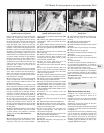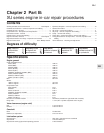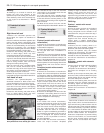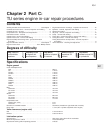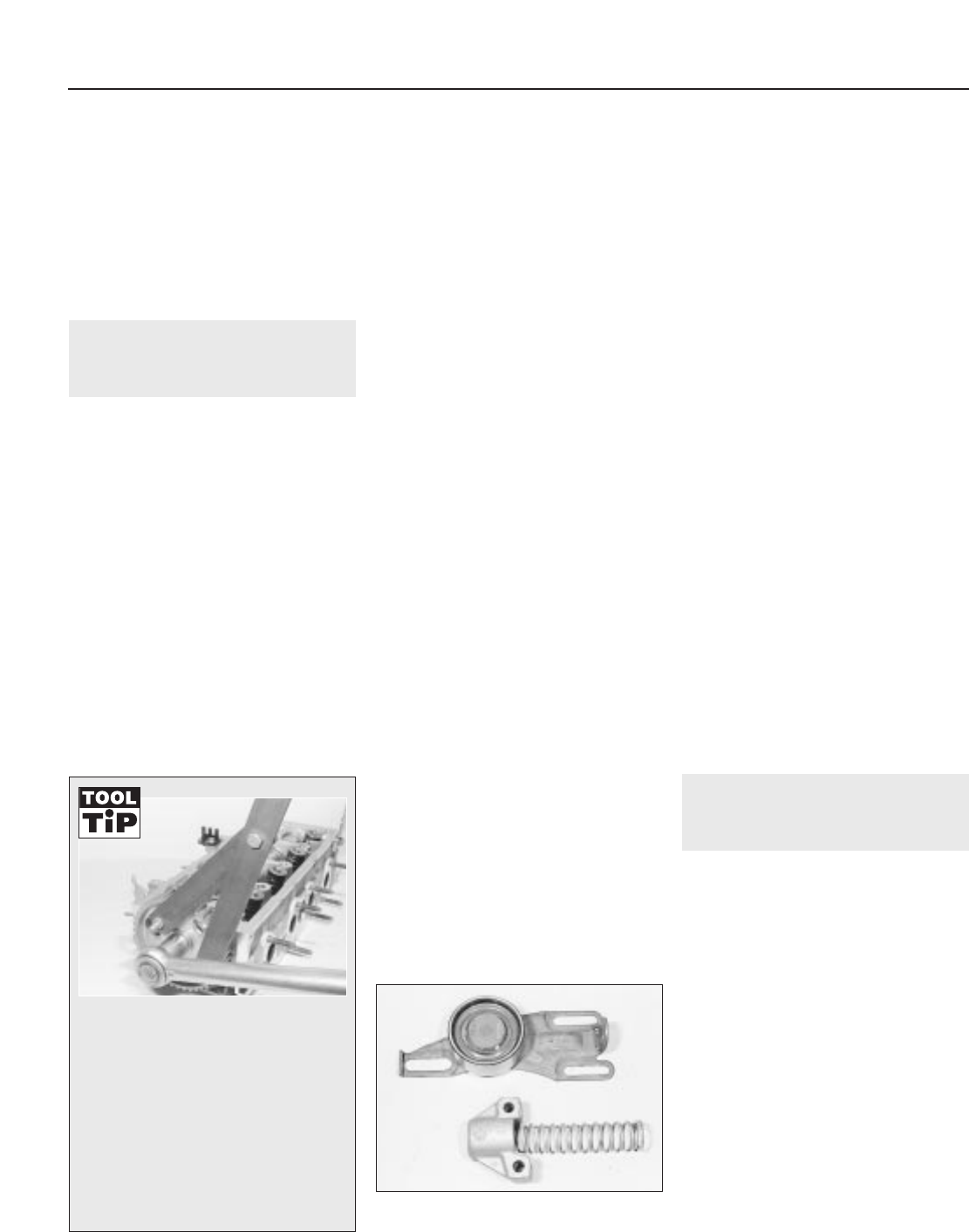
is available, it should be refitted to the
tensioned run of the belt. The reading should
now be between 42 and 46 units.
37 If the tension is not as specified, repeat
the tensioning operation.
38 Refit the belt covers and the crankshaft
pulley. Apply thread locking compound to the
crankshaft pulley bolt threads, and tighten the
bolt to the specified torque.
39 On completion, refit all disturbed
components, and tension the auxiliary
drivebelt, as described in Chapter 1.
5 Timing belt tensioner and
sprockets - removal,
inspection and refitting
3
Removal
Camshaft sprocket
1 Remove the timing belt as described in
Section 4.
2 Remove the locking pin from the camshaft
sprocket, slacken the sprocket retaining bolt
and remove it, along with its washer. To
prevent the camshaft rotating as the bolt is
slackened, restrain the sprocket with a
suitable tool through the holes in the sprocket
face (see Tool Tip). Do not attempt to use the
sprocket locking pin to prevent the sprocket
from rotating whilst the bolt is slackened.
3 With the retaining bolt removed, slide the
sprocket off the end of the camshaft. If the
locating peg is a loose fit in the rear of the
sprocket, remove it for safe-keeping. Examine
the camshaft oil seal for signs of oil leakage
and, if necessary, renew it as described in
Section 6.
Crankshaft sprocket
4 Remove the timing belt as described in
Section 4.
5 Slide the sprocket off the end of the
crankshaft. Remove the Woodruff key from
the crankshaft, and store it with the sprocket
for safe-keeping. Where necessary, also slide
the spacer (where fitted) off the end of the
crankshaft.
6 Examine the crankshaft oil seal for signs of
oil leakage and, if necessary, renew it as
described in Section 12.
Tensioner assembly (models with
spring-loaded tensioner)
7 Remove the timing belt as described in
Section 4.
8 Undo the two bolts at the front and single
nut at the rear and withdraw the spring
housing spring and tensioner pulley. Take
care to keep the spring under control as the
bolts are undone to prevent it flying out.
Tensioner assembly (models with
eccentric roller tensioner)
9 Remove the timing belt as described in
Section 4.
10 Slacken and remove the timing belt
tensioner pulley retaining bolt, and slide the
pulley off its mounting stud. Examine the
mounting stud for signs of damage and if
necessary, renew it.
Inspection
11 Clean the camshaft/crankshaft sprockets
thoroughly, and renew any that show signs of
wear, damage or cracks.
12 Clean the tensioner assembly, but do not
use any strong solvent which may enter the
pulley bearing. Check that the pulley rotates
freely on the backplate, with no sign of
stiffness or free play (see illustration). Renew
the assembly if there is any doubt about its
condition, or if there are any obvious signs of
wear or damage.
Refitting
Camshaft sprocket
13 Refit the locating peg (where removed) to
the rear of the sprocket. Locate the sprocket
on the end of the camshaft, ensuring that the
locating peg is correctly engaged with the
cut-out in the camshaft end.
14 Refit the sprocket retaining bolt and
washer, and tighten it to the specified torque.
Retain the sprocket with the tool used on
removal. Note that on early models the
sprocket is secured with an M12 bolt whereas
this has been reduced to M10 on later
engines. Ensure that the correct torque
wrench setting is used according to bolt type.
15 Realign the hole in the camshaft sprocket
with the corresponding hole in the cylinder
head, and refit the locking pin. Check that the
crankshaft pulley locking pin is still in position.
16 Refit the timing belt (Section 4).
Crankshaft sprocket
17 Slide the spacer (where fitted) into
position, taking great care not to damage the
crankshaft oil seal, and refit the Woodruff key
to its slot in the crankshaft end.
18 Slide on the crankshaft sprocket, aligning
its slot with the Woodruff key.
19 Refit the timing belt (Section 4).
Tensioner assembly (models with
spring-loaded tensioner)
20 Assemble the tensioner spring, spring
housing and pulley then locate the assembly
on the engine.
21 Fit the front bolts and rear locknut finger
tight only. Use a spanner on the square end of
the tensioner cam spindle to turn the cam to
the horizontal position and so compress the
tensioner spring. Tighten the cam locknut.
22 Refit the timing belt (Section 4).
Tensioner assembly (models with
eccentric roller tensioner)
23 Refit the tensioner pulley to its mounting
stud, and fit the retaining bolt.
24 Refit the timing belt (Section 4).
6 Camshaft oil seal - renewal
3
1 Remove the camshaft sprocket as
described in Section 5. Remove the rear cover
plate behind the sprocket.
2 Punch or drill two small holes opposite
each other in the oil seal. Screw a self-tapping
screw into each, and pull on the screws with
pliers to extract the seal.
3 Clean the seal housing, and polish off any
burrs or raised edges, which may have
caused the seal to fail in the first place.
4 Lubricate the lips of the new seal with clean
engine oil, and drive it into position until it
seats on its locating shoulder. Use a suitable
tubular drift, such as a socket, which bears
only on the hard outer edge of the seal. Take
care not to damage the seal lips during fitting.
Note that the seal lips should face inwards.
5 Refit the sprocket rear cover plate, locate it
correctly with a 10 mm dowel and tighten its
fastenings.
6 Refit the camshaft sprocket as described in
Section 5.
2B•6 XU series engine in-car repair procedures
5.12 Spring loaded timing belt tensioner
components
To make a camshaft sprocket holding
tool, obtain two lengths of steel strip
about 6 mm thick by 30 mm wide or
similar, one 600 mm long, the other 200
mm long (all dimensions approximate).
Bolt the two strips together to form a
forked end, leaving the bolt slack so
that the shorter strip can pivot freely. At
the end of each ‘prong’ of the fork,
secure a bolt with a nut and a locknut,
to act as the fulcrums; these will engage
with the cut-outs in the sprocket, and
should protrude by about 30 mm




